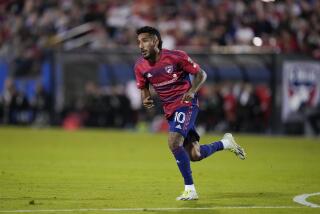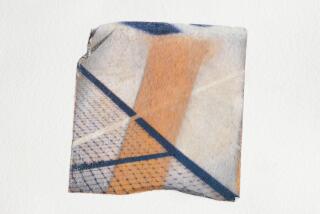Ardently Courting Capitalism : Tennis Marketing Is Playing a Role in Russia’s Attempt to Stimulate Its Sagging Economy
Boris Sobkin recently received his doctorate.
But teaching at a university in Moscow does little for his pocketbook.
His hope is tennis.
In part, the same might be true of Russia’s economy.
For Sobkin, it meant working for the third year in a row as a tournament driver at the Kremlin Cup, the final stop on the IBM/ATP Tour for 1992. A 44-year-old computer expert and tennis coach in his spare time, Sobkin was adding to his income, hustling to make ends meet by shepherding a group of tennis writers around a Saturday morning flea market. The grounds used to be a sports facility.
Welcome to Moscow and its sports’ transition to capitalism.
“Tennis and business, neither knows any borders,” said Victor Korobchenko, deputy mayor of Moscow, at a business symposium held during the Kremlin Cup. “Russia is a huge test ground for marketing relationships, and Moscow is a huge market. Both are waiting to be developed by domestic as well as foreign groups.”
Entitled “Russia: Developing an Economic Frontier,” the symposium made it quite clear that the Kremlin Cup is infusing the country with capital and hope.
“To show you how things have changed, I will tell you a story,” said Gene Scott, who has been the Kremlin Cup’s tournament director since its inception four years ago. “The first year, tournament drivers received 10 rubles an hour. The second year the rate went up to 30 rubles an hour. One of the drivers came to me and said he didn’t want rubles, he wanted dollars. Even when we offered to pay the drivers 60 rubles an hour, he still wanted a dollar an hour. All of which indicates, he had a good understanding of inflation and the way to succeed in the new economy.”
They succeeded in the cold and gray of Moscow in mid-November, the setting brightened by the Kremlin Cup, which, according to Scott, employed almost 2,000 local residents and returned $50 million to the economy.
Drivers like Sobkin were paid $2 to $3 an hour, not bad at a time when the rate of inflation was 2,100%. During the Kremlin Cup, the dollar-to-ruble exchange rate--not the one being quoted by the Moscow Interbank Currency Exchange--had vaulted from 390 to 500 rubles to the dollar.
“I used to coach (Andrei) Chesnokov,” Sobkin said, referring to the former top-10 player. “Right now I do a little coaching, help a few players. I would like to work with more and, maybe, in time come to America and coach there. I just received my doctorate. For here, 44 is a young age, but the university doesn’t pay that well. Tennis is a chance for me to do better. I really like the sport, and I can only hope I get a chance to coach.”
Tennis is not new in Russia. Leo Tolstoy founded the Moscow Tennis Club in the early 1900s. The Wimbledon men’s runner-up in 1973 was Alex Metreveli and the women’s runner-up in ’74 was Olga Morozova. Victor Korotkow won Wimbledon Junior Championships in 1965 and ’66 and Natasha Chmyreva won in 1975 and ’76.
In the late 1980s, perestroika carried over to tennis when Chesnokov and Natalia Zvereva withstood Soviet Tennis Federation threats and harassment and demanded economic change.
Thanks to their efforts, players from the former Soviet Union became free to travel, sign endorsement contracts, open bank accounts and keep their earnings. Gone were the times when the Soviet tennis federation granted daily per diems of less than $30 and collected most of a player’s prize winnings, as they did in 1988, when Chesnokov earned $496 from a winner’s check of $59,500. Tennis players were among Russia’s first capitalists.
Boris Yeltsin knows of capitalism. He is a man of change. He is also a tennis fan. That was clear during the Kremlin Cup singles final. Seated behind the north baseline, it didn’t matter whether Marc Rosset was rocketing a serve, or Rosset’s opponent, Carl Uwe-Steeb, was racing to a corner of the court to hit a picturesque groundstroke, Yeltsin was in action. Commenting and gesturing to members of his party, he was involved, appreciative, certainly having a good time.
The Russian president was equally animated after the match. He went down to center court, handed checks to Rosset, the winner, and runner-up Steeb, putting spirit in a situation that often has little stay-around-and-watch appeal.
The Kremlin Cup had seven good days. Attendance reached 76,778, providing both the economy and Moscovites with a lift.
“Everyone wants to be here,” said Inna, a shy woman in her 40s who, like most of the civilians interviewed, did not give her last name. A theater buff, Inna came to the matches with her husband, a devoted recreational tennis player who taught Inna the game.
“Tennis is important now,” she said. “There is so much money in the sport, in the business, and these days it’s also important to be at the right places.”
The tournament was the right place for Rosset, the Swiss Davis Cup standout. He took home a check of $45,000. At 500 rubles to the dollar, that comes to 22,500,000 rubles, large to those who earn less than $10,000 a year and incredible to a university professor, such as Sobkin, who might earn between 2,500-3,500 rubles a month.
“Tickets are between 10 and 25 rubles ordinarily. For the final matches it’s 100 to 150,” said Vadim, a fan in his 50s. “The price for tickets is a minimum. At a satellite tournament earlier this year, girls went for free. That means many people can watch the very good players play.”
The game fosters hope for the masses.
“Hundreds of young girls and boys pay 1,000 rubles a month to attend the Moscow Tennis Academy,” said Nina, a former university tennis player in her 30s who accompanied Vadim. “It’s a tennis university for children, and it was started this year. I find it very strange because the country is in economic crisis. These people are very rich, so they have their children in tennis. That’s all they care about, and they will pay almost anything so their children can play. Tennis has so much money. That’s why they are interested. So many former Soviet players have made so much money. They have made tennis very interesting.”
Overseeing the growth was Semyon Belits-Geiman, vice president of the USSR Tennis Federation since 1944. A ranked player in his day, author of 10 tennis books and currently involved with the development of the Moscow Tennis Academy, Belits-Geiman is a tennis insider.
“Tennis is the window to the world, and the children are our hope,” he said while at a table in the Kremlin Cup’s VIP Lounge.
“Many people dream about coming here, coming to Moscow, to see the tennis. It is a very popular sport,” he said. “We are lucky the government likes tennis. Yeltsin plays. So does his grandson Boris. Many of those around Yeltsin also play. So does the president of the Olympic Committee.”
Asked about the financing of the Moscow Tennis Academy, Belits-Geiman was uncharacteristically silent. But when it came to the academy’s philosophy, he responded with a flowing explanation.
“The aim is to organize the best players,” he said. “It’s a special program, one that combines tennis with school. For a year we visited the U.S. and the Academy is like the academies there.
“Players are picked by special scientific selection, and different groups pay different amounts. The most talented young men do not pay. If a child comes from a rather poor family and is good, he will not pay. Generally, it’s 300 rubles a month. Some of the players, people like (Andrei) Cherkasov, have said they will help.”
The biggest problem facing tennis in Russia is financing, whether it’s tuition to the Moscow Tennis Academy or building facilities. There is talk about a Moscow Wimbledon. “We have a Moscow White House,” Belits-Geiman said. “Why not a Moscow Wimbledon?”
The funding from “sponsors, trade unions and newspapers”--along with the support the Kremlin Cup provides junior tennis--will not keep the tennis federation out of the red.
“The biggest difficulty is finances,” Belits-Geiman said. “But this is not all bad. With difficulty, one becomes stronger. That is just like playing tennis. You have to face difficulty to become a better player.”
Katya and Julia, both 11, are among the best junior players in Moscow. They played an exhibition before the Kremlin Cup.
Katya spent last spring in the United States. Along with 11 members of her club, she played in tournaments and participated in club exchanges in Pennsylvania, Georgia and Florida.
Julia and Katya have talked about playing tennis in America, talked about realizing their dream. How they will accomplish the task, they are not sure.
“We live in a complicated time, but events like this tournament provide us with an opportunity to temporarily bring back some joy, smiles and hope,” said Yuri Luzhov, mayor of Moscow. “And we all need hope desperately right now.”
More to Read
Sign up for Essential California
The most important California stories and recommendations in your inbox every morning.
You may occasionally receive promotional content from the Los Angeles Times.










